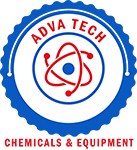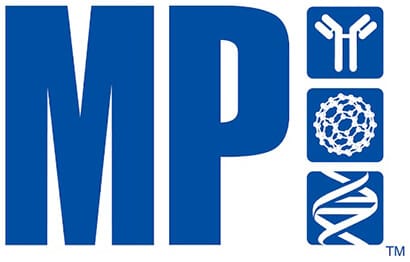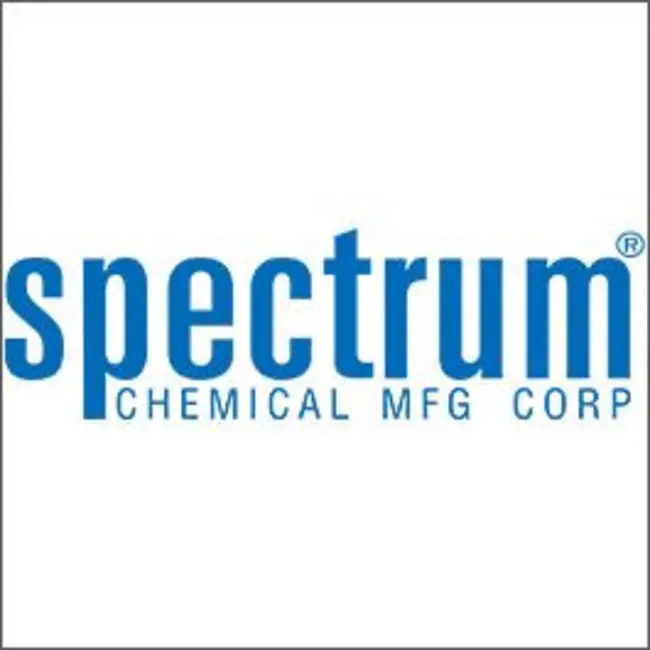GenScript Biotech
Showing 401–450 of 2554 results
-
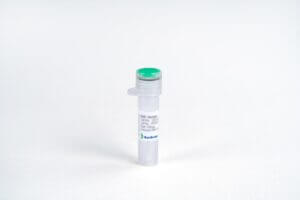
CD28 Fc Chimera, Human
$129.38 Add to cart View Product DetailsHuman CD28 is composed of four exons encoding a protein of 220 amino acids that is expressed on the cell surface as a glycosylated, disulfide-linked homodimer of 44 kDa. Members of the CD28 family share a number of common features. These receptors consist of paired V-set immunoglobulin superfamily (IgSF) domains attached to single transmembrane domains and cytoplasmic domains that contain critical signaling motifs. The CD28 and CTLA4 ligands, CD80 and CD86, consist of single V-set and C1-set IgSF domains. The interaction of these costimulatory receptors with ligands is mediated through the MYPPPY motif within the receptor V-set domains. CD28 is expressed constitutively on almost all human CD4 T cells and approximately 50% of CD8 T cells. CD28 costimulation has diverse effects on T cell function, including biochemical events at the immunological synapse, downstream phosphorylation and other post-translational modifications, transcriptional changes, and cytoskeletal remodeling. At the most basic level, CD28 signals increase a cell’s glycolytic rate, allowing cells to generate the energy necessary for growth and proliferation.
-

CD30, hFc, Human
$172.50 Add to cart View Product DetailsCD30, also known as TNFRSF8, is a cell membrane protein of the tumor necrosis factor receptor family, which regulates proliferation/apoptosis and antibody responses. CD30 is expressed by activated, but not by resting, T and B cells. Aberrant expression of CD30 by mastocytosis mast cells and interaction with its ligand CD30L (CD153) appears to play an important role in the pathogenesis and clinical presentation of systemic mastocytosis. CD30 has been considered as a specific diagnostic biomarker of anaplastic large cell lymphoma (ALCL) and classical Hodgkin lymphoma (cHL). CD30 is also a biomarker used for targeted therapy by an antibody–drug conjugate.
-

CD30, His, Human
$1,035.00 Add to cart View Product DetailsCD30, also known as TNFRSF8, is a cell membrane protein of the tumor necrosis factor receptor family, which regulates proliferation/apoptosis and antibody responses. CD30 is expressed by activated, but not by resting, T and B cells. Aberrant expression of CD30 by mastocytosis mast cells and interaction with its ligand CD30L (CD153) appears to play an important role in the pathogenesis and clinical presentation of systemic mastocytosis. CD30 has been considered as a specific diagnostic biomarker of anaplastic large cell lymphoma (ALCL) and classical Hodgkin lymphoma (cHL). CD30 is also a biomarker used for targeted therapy by an antibody–drug conjugate.
-

CD30, His, Human
$172.50 Add to cart View Product DetailsCD30, also known as TNFRSF8, is a cell membrane protein of the tumor necrosis factor receptor family, which regulates proliferation/apoptosis and antibody responses. CD30 is expressed by activated, but not by resting, T and B cells. Aberrant expression of CD30 by mastocytosis mast cells and interaction with its ligand CD30L (CD153) appears to play an important role in the pathogenesis and clinical presentation of systemic mastocytosis. CD30 has been considered as a specific diagnostic biomarker of anaplastic large cell lymphoma (ALCL) and classical Hodgkin lymphoma (cHL). CD30 is also a biomarker used for targeted therapy by an antibody–drug conjugate.
-
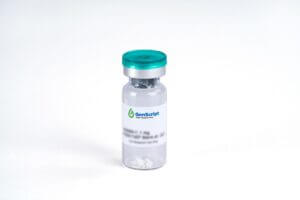
CD38, Human
$1,035.00 Add to cart View Product DetailsCD38 (also referred to as T10 antigen) is a nonlineage-restricted type II transmembrane glycoprotein that has emerged as an intracellular calcium ion mobilizing messenger. It can serve as an ectoenzyme that catalyzes the synthesis and hydrolysis of cyclic ADP-ribose. The enzymatic functions of CD38 probably contribute to an array of its immunoregulatory functions. It has been found on the surface of many immune cells (white blood cells), including CD4+, CD8+, B lymphocytes and natural killer cells. Soluble CD38 and the ability of membrane-bound CD38 to become internalized in response to appropriate stimuli suggest that extracellular and intracellular roles for this protein are equally plausible.
-

CD38, Human
$103.50 Add to cart View Product DetailsCD38 (also referred to as T10 antigen) is a nonlineage-restricted type II transmembrane glycoprotein that has emerged as an intracellular calcium ion mobilizing messenger. It can serve as an ectoenzyme that catalyzes the synthesis and hydrolysis of cyclic ADP-ribose. The enzymatic functions of CD38 probably contribute to an array of its immunoregulatory functions. It has been found on the surface of many immune cells (white blood cells), including CD4+, CD8+, B lymphocytes and natural killer cells. Soluble CD38 and the ability of membrane-bound CD38 to become internalized in response to appropriate stimuli suggest that extracellular and intracellular roles for this protein are equally plausible.
-

CD40, His, Human
$189.75 Add to cart View Product DetailsCD40 is a costimulatory protein found on antigen presenting cells and is required for their activation. The binding of CD154 (CD40L) on TH cells to CD40 activates antigen presenting cells and induces a variety of downstream effects.CD40 molecule is a potential target for cancer immunotherapy. There are number of completed and ongoing clinical trials where agonistic anti-CD40 monoclonal antibodies are employed to activate an anti-tumor T cell response via activation of dendritic cells.
-

CD40L/CD154/TRAP, Human
$1,035.00 Add to cart View Product DetailsCD40 Ligand (CD40L/CD154/TRAP) is a membrane glycoprotein and differentiation antigen expressed on the surface of T-cells. The CD40 ligand stimulates B-cell proliferation and secretion of all immunoglobulin isotypes in the presence of cytokines. It also costimulates proliferation of activated T-cell and this is accompanied by the production of IFN-γ, TNF-α, and IL2. CD40 ligand has been shown to induce cytokine production and tumoricidal activity in peripheral blood monocytes.
-

CD40L/CD154/TRAP, Human
$64.69 Add to cart View Product DetailsCD40 Ligand (CD40L/CD154/TRAP) is a membrane glycoprotein and differentiation antigen expressed on the surface of T-cells. The CD40 ligand stimulates B-cell proliferation and secretion of all immunoglobulin isotypes in the presence of cytokines. It also costimulates proliferation of activated T-cell and this is accompanied by the production of IFN-γ, TNF-α, and IL2. CD40 ligand has been shown to induce cytokine production and tumoricidal activity in peripheral blood monocytes.
-

CD40L/CD154/TRAP, Human
$159.56 Add to cart View Product DetailsCD40 Ligand (CD40L/CD154/TRAP) is a membrane glycoprotein and differentiation antigen expressed on the surface of T-cells. The CD40 ligand stimulates B-cell proliferation and secretion of all immunoglobulin isotypes in the presence of cytokines. It also costimulates proliferation of activated T-cell and this is accompanied by the production of IFN-γ, TNF-α, and IL2. CD40 ligand has been shown to induce cytokine production and tumoricidal activity in peripheral blood monocytes.
-

CD47 Fc Chimera, Human
$1,293.75 Add to cart View Product DetailsLeukocyte surface antigen CD47 is also known as Antigenic surface determinant protein OA3, Integrin-associated protein (IAP) and Protein MER6. CD47 contains 1 Ig-like V-type (immunoglobulin-like) domain. CD47 is a 40‑60 kDa variably glycosylated atypical member of the immunoglobulin superfamily and an integral membrane protein that consists of a 123 amino acid (aa) extracellular domain (ECD) with a single Ig-like domain, five membrane-spanning regions with short intervening loops, and a 34 aa C-terminal cytoplasmic tail. CD47 has a role in both cell adhesion by acting as an adhesion receptor for THBS1 on platelets, and in the modulation of integrins and plays an important role in memory formation and synaptic plasticity in the hippocampus by similarity. CD47 is the receptor for SIRPA, binding to which prevents maturation of immature dendritic cells and inhibits cytokine production by mature dendritic cells. CD47 Interaction with SIRPG mediates cell-cell adhesion, enhances superantigen-dependent T-cell-mediated proliferation and costimulates T-cell activation.
-

CD47 Fc Chimera, Human
$301.88 Add to cart View Product DetailsLeukocyte surface antigen CD47 is also known as Antigenic surface determinant protein OA3, Integrin-associated protein (IAP) and Protein MER6. CD47 contains 1 Ig-like V-type (immunoglobulin-like) domain. CD47 is a 40‑60 kDa variably glycosylated atypical member of the immunoglobulin superfamily and an integral membrane protein that consists of a 123 amino acid (aa) extracellular domain (ECD) with a single Ig-like domain, five membrane-spanning regions with short intervening loops, and a 34 aa C-terminal cytoplasmic tail. CD47 has a role in both cell adhesion by acting as an adhesion receptor for THBS1 on platelets, and in the modulation of integrins and plays an important role in memory formation and synaptic plasticity in the hippocampus by similarity. CD47 is the receptor for SIRPA, binding to which prevents maturation of immature dendritic cells and inhibits cytokine production by mature dendritic cells. CD47 Interaction with SIRPG mediates cell-cell adhesion, enhances superantigen-dependent T-cell-mediated proliferation and costimulates T-cell activation.
-

CD47, His, Human
$1,293.75 Add to cart View Product DetailsLeukocyte surface antigen CD47 is also known as Antigenic surface determinant protein OA3, Integrin-associated protein (IAP) and Protein MER6. CD47 contains 1 Ig-like V-type (immunoglobulin-like) domain. CD47 is a 40‑60 kDa variably glycosylated atypical member of the immunoglobulin superfamily and an integral membrane protein that consists of a 123 amino acid (aa) extracellular domain (ECD) with a single Ig-like domain, five membrane-spanning regions with short intervening loops, and a 34 aa C-terminal cytoplasmic tail. CD47 has a role in both cell adhesion by acting as an adhesion receptor for THBS1 on platelets, and in the modulation of integrins and plays an important role in memory formation and synaptic plasticity in the hippocampus by similarity. CD47 is the receptor for SIRPA, binding to which prevents maturation of immature dendritic cells and inhibits cytokine production by mature dendritic cells. CD47 Interaction with SIRPG mediates cell-cell adhesion, enhances superantigen-dependent T-cell-mediated proliferation and costimulates T-cell activation.
-

CD47, His, Human
$301.88 Add to cart View Product DetailsLeukocyte surface antigen CD47 is also known as Antigenic surface determinant protein OA3, Integrin-associated protein (IAP) and Protein MER6. CD47 contains 1 Ig-like V-type (immunoglobulin-like) domain. CD47 is a 40‑60 kDa variably glycosylated atypical member of the immunoglobulin superfamily and an integral membrane protein that consists of a 123 amino acid (aa) extracellular domain (ECD) with a single Ig-like domain, five membrane-spanning regions with short intervening loops, and a 34 aa C-terminal cytoplasmic tail. CD47 has a role in both cell adhesion by acting as an adhesion receptor for THBS1 on platelets, and in the modulation of integrins and plays an important role in memory formation and synaptic plasticity in the hippocampus by similarity. CD47 is the receptor for SIRPA, binding to which prevents maturation of immature dendritic cells and inhibits cytokine production by mature dendritic cells. CD47 Interaction with SIRPG mediates cell-cell adhesion, enhances superantigen-dependent T-cell-mediated proliferation and costimulates T-cell activation.
-
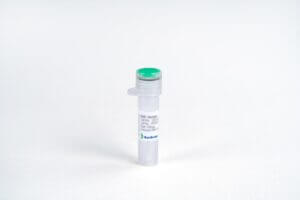
CD48/SLAMF2 Fc Chimera, Human
$1,035.00 Add to cart View Product DetailsCD48 antigen (Cluster of Differentiation 48) also known as B-lymphocyte activation marker (BLAST-1) or signaling lymphocytic activation molecule 2 (SLAMF2) is a protein that in humans is encoded by the CD48 gene. CD48 is a member of the CD2 subfamily of the immunoglobulin superfamily (IgSF) which includes SLAM (signaling lymphocyte activation molecules) proteins, such as CD84, CD150, CD229 and CD244. CD48 is found on the surface of lymphocytes and other immune cells, dendritic cells and endothelial cells, and participates in activation and differentiation pathways in these cells. CD48 was the first B-cell-specific cellular differentiation antigen identified in transformed B lymphoblasts.
-

CD48/SLAMF2 Fc Chimera, Human
$172.50 Add to cart View Product DetailsCD48 antigen (Cluster of Differentiation 48) also known as B-lymphocyte activation marker (BLAST-1) or signaling lymphocytic activation molecule 2 (SLAMF2) is a protein that in humans is encoded by the CD48 gene. CD48 is a member of the CD2 subfamily of the immunoglobulin superfamily (IgSF) which includes SLAM (signaling lymphocyte activation molecules) proteins, such as CD84, CD150, CD229 and CD244. CD48 is found on the surface of lymphocytes and other immune cells, dendritic cells and endothelial cells, and participates in activation and differentiation pathways in these cells. CD48 was the first B-cell-specific cellular differentiation antigen identified in transformed B lymphoblasts.
-

CD73, His, Human
$2,070.00 Add to cart View Product DetailsCD73, also known as ecto-5′-nucleotidase, is an enzyme that in humans is encoded by the NT5E gene.CD73 commonly serves to convert AMP to adenosine.The enzyme consists of a dimer of 2 identical 70-kD subunits bound by a glycosyl phosphatidyl inositol linkage to the external face of the plasma membrane. The enzyme is used as a marker of lymphocyte differentiation. A deficiency of CD73 occurs in a variety of immunodeficiency diseases.
-

CD73, His, Human
$301.88 Add to cart View Product DetailsCD73, also known as ecto-5′-nucleotidase, is an enzyme that in humans is encoded by the NT5E gene.CD73 commonly serves to convert AMP to adenosine.The enzyme consists of a dimer of 2 identical 70-kD subunits bound by a glycosyl phosphatidyl inositol linkage to the external face of the plasma membrane. The enzyme is used as a marker of lymphocyte differentiation. A deficiency of CD73 occurs in a variety of immunodeficiency diseases.
-
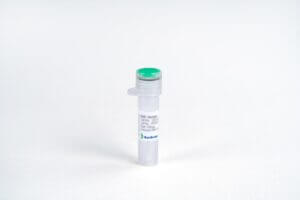
CD96, His, Human
$1,293.75 Add to cart View Product DetailsCD96 (Cluster of Differentiation 96), also known as Tactile (T cell activation, increased late expression), is a receptor protein which is expressed on T cells and NK cells and shares sequence similarity with CD226 (also known as DNAM-1). The main ligand of CD96 is CD155 and CD96 competes with CD226 for binding to CD155. This protein belongs to the immunoglobulin superfamily and may play a role in the adhesive interactions of activated T and NK cells during the late phase of the immune response. It may also promote NK cell-target adhesion by interacting with PVR present on target cells and function in antigen presentation.
-

CD96, His, Human
$189.75 Add to cart View Product DetailsCD96 (Cluster of Differentiation 96), also known as Tactile (T cell activation, increased late expression), is a receptor protein which is expressed on T cells and NK cells and shares sequence similarity with CD226 (also known as DNAM-1). The main ligand of CD96 is CD155 and CD96 competes with CD226 for binding to CD155. This protein belongs to the immunoglobulin superfamily and may play a role in the adhesive interactions of activated T and NK cells during the late phase of the immune response. It may also promote NK cell-target adhesion by interacting with PVR present on target cells and function in antigen presentation.
-

CD96, His, Human
$137.14 Add to cart View Product DetailsCD96 (Cluster of Differentiation 96), also known as Tactile (T cell activation, increased late expression), is a receptor protein which is expressed on T cells and NK cells and shares sequence similarity with CD226 (also known as DNAM-1). The main ligand of CD96 is CD155 and CD96 competes with CD226 for binding to CD155. This protein belongs to the immunoglobulin superfamily and may play a role in the adhesive interactions of activated T and NK cells during the late phase of the immune response. It may also promote NK cell-target adhesion by interacting with PVR present on target cells and function in antigen presentation.
-
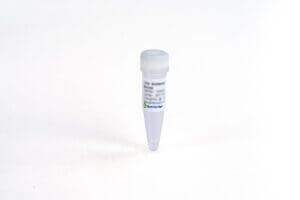
CEA (RC66), mAb, Mouse
$104.36 Add to cart View Product DetailsCarcinoembroyonic antigen (CEA) is a glycoprotein, produced during the embryonic and fetal period. The high concentration of CEA in blood are observed in many patients with cancer of the lung, liver, pancreas, breast, colon and prostate. The elevated CEA levels are related to the stage of the disease.
-

CEA (RC66), mAb, Mouse
$1,043.63 Add to cart View Product DetailsCarcinoembroyonic antigen (CEA) is a glycoprotein, produced during the embryonic and fetal period. The high concentration of CEA in blood are observed in many patients with cancer of the lung, liver, pancreas, breast, colon and prostate. The elevated CEA levels are related to the stage of the disease.
-

CEA (RC66), mAb, Mouse
$8,883.75 Add to cart View Product DetailsCarcinoembroyonic antigen (CEA) is a glycoprotein, produced during the embryonic and fetal period. The high concentration of CEA in blood are observed in many patients with cancer of the lung, liver, pancreas, breast, colon and prostate. The elevated CEA levels are related to the stage of the disease.
-

CEA (RC67), mAb, Mouse
$104.36 Add to cart View Product DetailsCarcinoembroyonic antigen (CEA) is a glycoprotein, produced during the embryonic and fetal period. The high concentration of CEA in blood are observed in many patients with cancer of the lung, liver, pancreas, breast, colon and prostate. The elevated CEA levels are related to the stage of the disease.
-

CEA (RC67), mAb, Mouse
$1,043.63 Add to cart View Product DetailsCarcinoembroyonic antigen (CEA) is a glycoprotein, produced during the embryonic and fetal period. The high concentration of CEA in blood are observed in many patients with cancer of the lung, liver, pancreas, breast, colon and prostate. The elevated CEA levels are related to the stage of the disease.
-

CEA (RC67), mAb, Mouse
$8,883.75 Add to cart View Product DetailsCarcinoembroyonic antigen (CEA) is a glycoprotein, produced during the embryonic and fetal period. The high concentration of CEA in blood are observed in many patients with cancer of the lung, liver, pancreas, breast, colon and prostate. The elevated CEA levels are related to the stage of the disease.
-

CEA Fc chimera, Human
$1,293.75 Add to cart View Product DetailsCarcinoembryonic antigen (CEA) also known as Carcinoembryonic antigen-related cell adhesion molecule 5 (CEACAM5), CD antigen CD66e, Meconium antigen 100, is an oncofetal glycoprotein that is normally expressed by mucosal cells. CEA is a member of the immunoglobulin (Ig) superfamily of proteins. CEA is a glycophosphatidylinositol- (GPI-) linked membrane-anchoring protein that is exposed to the cell surface that faces the extracellular matrix. The membrane-anchoring region of CEA can be cleaved by phospholipase C and phospholipase D. The cleaved products are soluble and circulating through blood vessels. Thus, CEA can be present as secreted and cell surface-anchored forms. CEA is functionally associated with cellular interaction, cell adhesion, immune response, anoikis resistance, and promotion of liver metastasis. CEA overexpression is associated with many types of cancers including gastrointestinal, respiratory, and genitourinary system and breast cancers.
-

CEA Fc chimera, Human
$194.06 Add to cart View Product DetailsCarcinoembryonic antigen (CEA) also known as Carcinoembryonic antigen-related cell adhesion molecule 5 (CEACAM5), CD antigen CD66e, Meconium antigen 100, is an oncofetal glycoprotein that is normally expressed by mucosal cells. CEA is a member of the immunoglobulin (Ig) superfamily of proteins. CEA is a glycophosphatidylinositol- (GPI-) linked membrane-anchoring protein that is exposed to the cell surface that faces the extracellular matrix. The membrane-anchoring region of CEA can be cleaved by phospholipase C and phospholipase D. The cleaved products are soluble and circulating through blood vessels. Thus, CEA can be present as secreted and cell surface-anchored forms. CEA is functionally associated with cellular interaction, cell adhesion, immune response, anoikis resistance, and promotion of liver metastasis. CEA overexpression is associated with many types of cancers including gastrointestinal, respiratory, and genitourinary system and breast cancers.
-

CEA Fc chimera, Human
$138.00 Add to cart View Product DetailsCarcinoembryonic antigen (CEA) also known as Carcinoembryonic antigen-related cell adhesion molecule 5 (CEACAM5), CD antigen CD66e, Meconium antigen 100, is an oncofetal glycoprotein that is normally expressed by mucosal cells. CEA is a member of the immunoglobulin (Ig) superfamily of proteins. CEA is a glycophosphatidylinositol- (GPI-) linked membrane-anchoring protein that is exposed to the cell surface that faces the extracellular matrix. The membrane-anchoring region of CEA can be cleaved by phospholipase C and phospholipase D. The cleaved products are soluble and circulating through blood vessels. Thus, CEA can be present as secreted and cell surface-anchored forms. CEA is functionally associated with cellular interaction, cell adhesion, immune response, anoikis resistance, and promotion of liver metastasis. CEA overexpression is associated with many types of cancers including gastrointestinal, respiratory, and genitourinary system and breast cancers.
-

CEA, His, Human
$1,293.75 Add to cart View Product DetailsCarcinoembryonic antigen (CEA) also known as Carcinoembryonic antigen-related cell adhesion molecule 5 (CEACAM5), CD antigen CD66e, Meconium antigen 100, is an oncofetal glycoprotein that is normally expressed by mucosal cells. CEA is a member of the immunoglobulin (Ig) superfamily of proteins. CEA is a glycophosphatidylinositol- (GPI-) linked membrane-anchoring protein that is exposed to the cell surface that faces the extracellular matrix. The membrane-anchoring region of CEA can be cleaved by phospholipase C and phospholipase D. The cleaved products are soluble and circulating through blood vessels. Thus, CEA can be present as secreted and cell surface-anchored forms. CEA is functionally associated with cellular interaction, cell adhesion, immune response, anoikis resistance, and promotion of liver metastasis. CEA overexpression is associated with many types of cancers including gastrointestinal, respiratory, and genitourinary system and breast cancers.
-

CEA, His, Human
$194.06 Add to cart View Product DetailsCarcinoembryonic antigen (CEA) also known as Carcinoembryonic antigen-related cell adhesion molecule 5 (CEACAM5), CD antigen CD66e, Meconium antigen 100, is an oncofetal glycoprotein that is normally expressed by mucosal cells. CEA is a member of the immunoglobulin (Ig) superfamily of proteins. CEA is a glycophosphatidylinositol- (GPI-) linked membrane-anchoring protein that is exposed to the cell surface that faces the extracellular matrix. The membrane-anchoring region of CEA can be cleaved by phospholipase C and phospholipase D. The cleaved products are soluble and circulating through blood vessels. Thus, CEA can be present as secreted and cell surface-anchored forms. CEA is functionally associated with cellular interaction, cell adhesion, immune response, anoikis resistance, and promotion of liver metastasis. CEA overexpression is associated with many types of cancers including gastrointestinal, respiratory, and genitourinary system and breast cancers.
-

CEA, His, Human
$138.00 Add to cart View Product DetailsCarcinoembryonic antigen (CEA) also known as Carcinoembryonic antigen-related cell adhesion molecule 5 (CEACAM5), CD antigen CD66e, Meconium antigen 100, is an oncofetal glycoprotein that is normally expressed by mucosal cells. CEA is a member of the immunoglobulin (Ig) superfamily of proteins. CEA is a glycophosphatidylinositol- (GPI-) linked membrane-anchoring protein that is exposed to the cell surface that faces the extracellular matrix. The membrane-anchoring region of CEA can be cleaved by phospholipase C and phospholipase D. The cleaved products are soluble and circulating through blood vessels. Thus, CEA can be present as secreted and cell surface-anchored forms. CEA is functionally associated with cellular interaction, cell adhesion, immune response, anoikis resistance, and promotion of liver metastasis. CEA overexpression is associated with many types of cancers including gastrointestinal, respiratory, and genitourinary system and breast cancers.
-
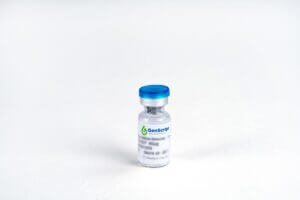
cGFP-tag Antibody, mAb, Mouse
$87.98 Add to cart View Product DetailsThe antibody reacts with various forms of GFP including eGFP, OFP, and GFPuv.
-

cGMP ELISA Detection Kit
$256.16 Add to cart View Product DetailsKit Description
GenScript cGMP ELISA Detection Kit is a competition enzyme-linked immunoassay which can be used for quantitative detection of cGMP (Guanosine 3′,5′-cyclic monophosphate) in samples such as serum, plasma, saliva, cell culture supernatant, and urine. cGMP is an important secondary messenger in signal transduction pathways. It is a common regulator of ion channel conductance, glycogenolysis, and cellular apoptosis. cGMP is a cyclic nucleotide derived from guanosine triphosphate (GTP). The cellular production of cGMP is mediated by Guanylate cyclase (GC). It activates the cGMP-dependent protein kinases which in turn phosphorylate several downstream protein targets. cGMP has an effect on the regulation of cAMP levels by activating or inhibiting specific phosphodiesterases (PDEs).
The anti-IgG Capture Plate is pre-coated with fixed amount of Goat anti-rabbit IgG to capture Rabbit Anti-cGMP Polyclonal Antibody. When free cGMP or specimen and HRP-cGMP conjugate are added to the well, they compete in the solution to interact with the cGMP antibody captured on the plate. Other unbound molecules are removed by a wash step. The cGMP-HRP reacts with TMB substrate to develop a blue product in the solution. The reaction is stopped by adding stop solution and the color turns yellow which can be read at 450 nm by a Microtiter plate reader. Using the standard curve, the amount of cGMP present in the unknown samples can be calculated by transforming its absorbance value.
-

cGMP-HRP
$94.01 Add to cart View Product DetailscGMP-peroxidase conjugate is a product most suitable for GenScript’s THETM Anti cGMP monoclonal antibody (Cat. No. A01508) and Rabbit Anti-cGMP polyclonal antibody (Cat. No. A00615) in immunoassay development for cGMP detection. HRP is conjugated to the C-8 position of cGMP.
-

CHO-K1/ mouse PD-1 Stable Cell Line
$7,331.25 Add to cart View Product DetailsProgrammed cell death protein 1, also known as PD-1 and CD279 (cluster of differentiation 279), is a protein that in humans is encoded by the PDCD1 gene.PD-1, functioning as an immune checkpoint, plays an important role in down regulating the immune system by preventing the activation of T-cells, which in turn reduces autoimmunity and promotes self-tolerance. The inhibitory effect of PD-1 is accomplished through a dual mechanism of promoting apoptosis (programmed cell death) in antigen specific T-cells in lymph nodes while simultaneously reducing apoptosis in regulatory T cells (suppressor T cells).
-

CHO-K1/4-1BB Stable Cell Line
$7,331.25 Add to cart View Product DetailsCD137 is a member of the tumor necrosis factor (TNF) receptor family. Its alternative names are tumor necrosis factor receptor superfamily member 9 (TNFRSF9), 4-1BB and induced by lymphocyte activation (ILA). It is currently of interest to immunologists as a co-stimulatory immune checkpoint molecule.
-

CHO-K1/5-HT1A/Gα15 Stable Cell Line
$7,331.25 Add to cart View Product DetailsThe 5-Hydroxytryptamine receptor 1A (5-HT1A) is Gi-coupled GPCRs expressed in the cerebral cortex, hippocampus, septum, amygdala, and raphe nucelus, with lesser amounts in the basal ganglia and thalamus. Many functions of the central nervous system are influenced by 5-HT, including sleep, motor activity, sensory perception, arousal and appetite. 5-HT1A ligands may prove to be therapeutic in the treatment of various disorders such as depression, anxiety, and schizophrenia.
-

CHO-K1/5-HT2A Stable Cell Line
$7,331.25 Add to cart View Product Details5-Hydroxytryptamine (5-HT, also commonly known as serotonin) is synthesized in enterochromaffin cells in the intestine and in serotonergic nerve terminals. In the periphery, 5-HT mediates gastrointestinal motility, platelet aggregation, and contraction of blood vessels. Many functions of the central nervous system are influenced by 5-HT, including sleep, motor activity, sensory perception, arousal, and appetite. A family of 12 GPCRs and one ion channel mediate the biological effects of 5-HT (Hoyer et al., 1994). 5-HT2A which couples to Gq/11 is expressed throughout the central nervous system in the neocortex and olfactory tubercle. 5-HT2A receptor agonists may have important clinical value in the treatment of various disorders, such as depression, anxiety, bipolar disorder, and schizophrenia. GenScript’s cloned human 5-HT2A–expressing cell line is generated in the CHO-K1 host.
-

CHO-K1/5-HT2B Stable Cell Line
$7,331.25 Add to cart View Product Details5-Hydroxytryptamine (5-HT, also commonly known as serotonin) is synthesized in enterochromaffin cells in the intestine and in serotonergic nerve terminals. In the periphery, 5-HT mediates gastrointestinal motility, platelet aggregation, and contraction of blood vessels. Many functions of the central nervous system are influenced by 5-HT, including sleep, motor activity, sensory perception, arousal and appetite. A family of 12 GPCRs and one ion channel mediate the biological effects of 5-HT (Hoyer et al., 1994). 5-HT2B which couples to Gq/11 is expressed in embryonic and adult cardiovascular tissues, gut, and brain from the rat, mouse, and human species. 5-HT2B receptors are responsible for many cardiovascular and central nervous system functions, such as blood vessel contraction, platelet shape changes, neuronal sensitization to tactile stimuli, and mediation of the hallucinogenic effects of phenylisopropylamin hallucinogens. It has also been shown to be required for heart development. GenScript’s cloned human 5-HT2B -expressing cell line is generated in the CHO-K1 host.
-

CHO-K1/5-HT2C Stable Cell Line
$7,331.25 Add to cart View Product Details5-Hydroxytryptamine (5-HT, also commonly known as serotonin) is synthesized in enterochromaffin cells in the intestine and in serotonergic nerve terminals. In the periphery, 5-HT mediates gastrointestinal motility, platelet aggregation, and contraction of blood vessels. Many functions of the central nervous system are influenced by 5-HT, including sleep, motor activity, sensory perception, arousal, and appetite. A family of 12 GPCRs and one ion channel mediate the biological effects of 5-HT (Hoyer et al., 1994). 5-HT2C is expressed in the brain and spinal cord, especially the choroid plexus. 5-HT2C receptor agonists may have important clinical value in the treatment of mental and eating disorders, such as depression, panic anxiety, OCD, bulimia, and obesity. GenScript’s cloned human 5-HT2C-expressing cell line is generated in the CHO-K1 host.
-

CHO-K1/ACE2 Stable Cell Line
$6,468.75 Add to cart View Product DetailsRecombinant CHO-K1 cells stably express Angiotensin-converting enzyme 2 (ACE2) on the cell surface. The surface expression of ACE2 is validated by FACS analysis. This stable cell line product is designed for cell-based binding assays that measure binding affinity and stability of antibody based biologics binding with ACE2.
-

CHO-K1/ADORA1/Gα15 Stable Cell Line
$7,331.25 Add to cart View Product DetailsA1 is a receptor for adenosine. It is demonstrated that the A1 receptor is ubiquitous throughout the entire body. Activation of A1 elicits an inhibition of adenylate cyclase and therefore a decrease in the cAMP concentration. A1 receptors are implicated in sleep promotion by inhibiting wake promoting cholinergic neurons in the basal forebrain. Adenosine antagonists are widely used in neonatal medicine.
-

CHO-K1/ADORA2A/Gα15 Stable Cell Line
$7,331.25 Add to cart View Product DetailsThe adenosine receptors ADORA2A is Gs-coupled GPCRs expressed in the thymus gland, heart, lung, kedney, brain, platelets, spleen and leukocytes. ADORA2A down-regulates chemokine receptor function and inhibits platelet aggregation. ADORA2A antagonists may be useful as therapy for Parkinson’s disease.
-

CHO-K1/ADORA2B/Gα15 Stable Cell Line
$7,331.25 Add to cart View Product DetailsThe adenosine receptors ADORA2B is Gs and Gq/11-coupled GPCR expressed in the Large intestine, cecum, urinary bladder. ADORA2B receptor mediates relaxation to adenosine in human small coronary arteries which is independent of NO but dependents in part on a K+-sensitive mechanism. Pharmacological or molecular biologic activation of ADORA2B receptor may prevent glomerular remodeling associated with glomerulosclerosis, renal disease, and abnormal growth associated with hypertension and diabetes.
-

CHO-K1/ADORA3/Gα15 Stable Cell Line
$7,331.25 Add to cart View Product DetailsExtracellular adenosine mediates a multitude of biological effects, including wakefulness, antiarrythmia, bronchoconstriction and response to ischemia and oxidative stress. A family of four G-protein coupled adrenoceptors, A1, A2A, A2B and A3, is responsible for these effects. A3, which couples to Gi/o, is expressed in a wide range of human tissues, but most predominantly in the lung and liver. Recent animal model studies have shown that A3 receptors play important roles in brain ischemia, immunosuppresion, and bronchospasm. A3 receptor agonists and/or agonists may have important clinical value in the treatment of asthma and inflammation. Mice lacking A3 receptors display reduced mast cell degranulation and bronchoconstriction in response to adenosine.
-

CHO-K1/ADRA1A Stable Cell Line
$7,331.25 Add to cart View Product DetailsThe α1-adrenergic receptor (AR) family consists of three closely related gene products (α1A, α1B, and α1D) that mediate the actions of norepinephrine (NE) and epinephrine in sympathetically innervated tissues and brain. α1-ARs belong to the G protein-coupled receptor family and consist of single polypeptide chains predicted to have seven transmembrane spanning domains. With similar pharmacological and signaling properties, α1-AR subtypes act through Gq/11 proteins to activate phospholipase C, increase both inositol 1,4,5-trisphosphate production and intracellular Ca2+. Once activated by binding, α1-ARs initiate the cellular pathways leading to the regulation of physiological effects, including blood pressure maintenance, glucose metabolism, renal sodium reabsorption, and cardiac inotropy.
-

CHO-K1/ADRA1B Stable Cell Line
$7,331.25 Add to cart View Product DetailsThe α1-adrenergic receptor (AR) family consists of three closely related gene products (α1A, α1B, and α1D). They mediate the actions of norepinephrine (NE) and epinephrine in sympathetically innervated tissues and brain. Α1-ARs belong to the G protein-coupled receptor family and consist of single polypeptide chains that are predicted to form seven transmembrane spanning domains. With similar pharmacological and signaling properties, α1-AR subtypes act through Gq/11 proteins to activate phospholipase C, increase inositol 1,4,5-trisphosphate production, and increase intracellular Ca2+. ADRA1B functions in diverse settings include vasoconstriction and myocardial contractility, neuronal dopaminergic responses, dendritic cell migration and inflammatory responses, as well as neuroendocrine regulation of fertility.
-

CHO-K1/ADRA1D Stable Cell Line
$7,331.25 Add to cart View Product DetailsThe α1-adrenergic receptor (AR) family consists of three closely related gene products (α1A, α1B, and α1D). They mediate the actions of norepinephrine (NE) and epinephrine in sympathetically innervated tissues and brain. α1-ARs belong to the G protein-coupled receptor family and consist of single polypeptide chains that are predicted to form seven transmembrane spanning domains. With similar pharmacological and signaling properties, α1-AR subtypes act through Gq/11 proteins to activate phospholipase C, increase inositol 1,4,5-trisphosphate production, and increase intracellular Ca2+.
